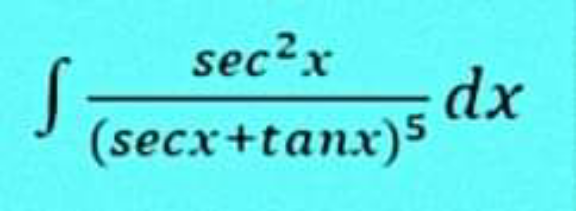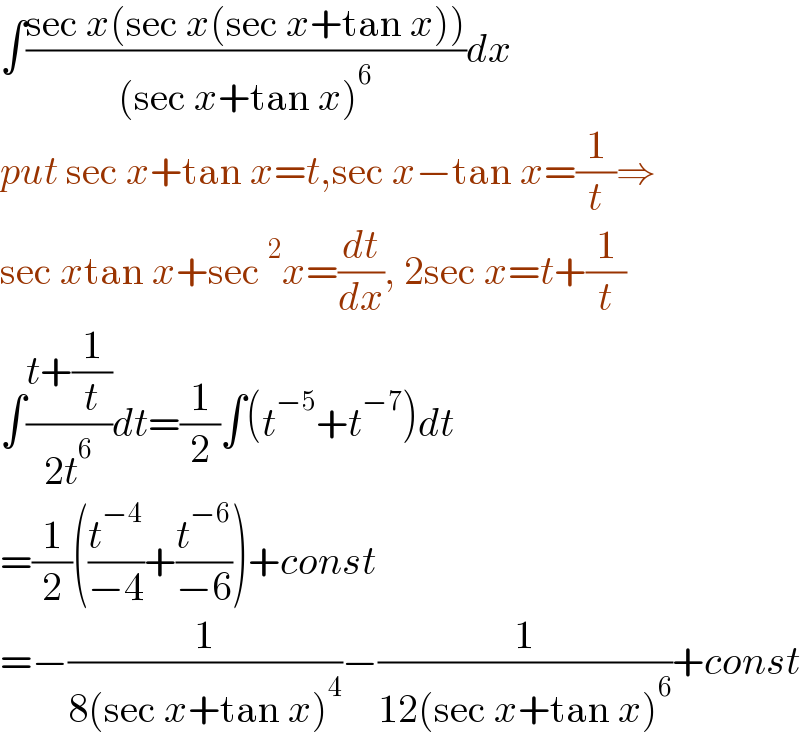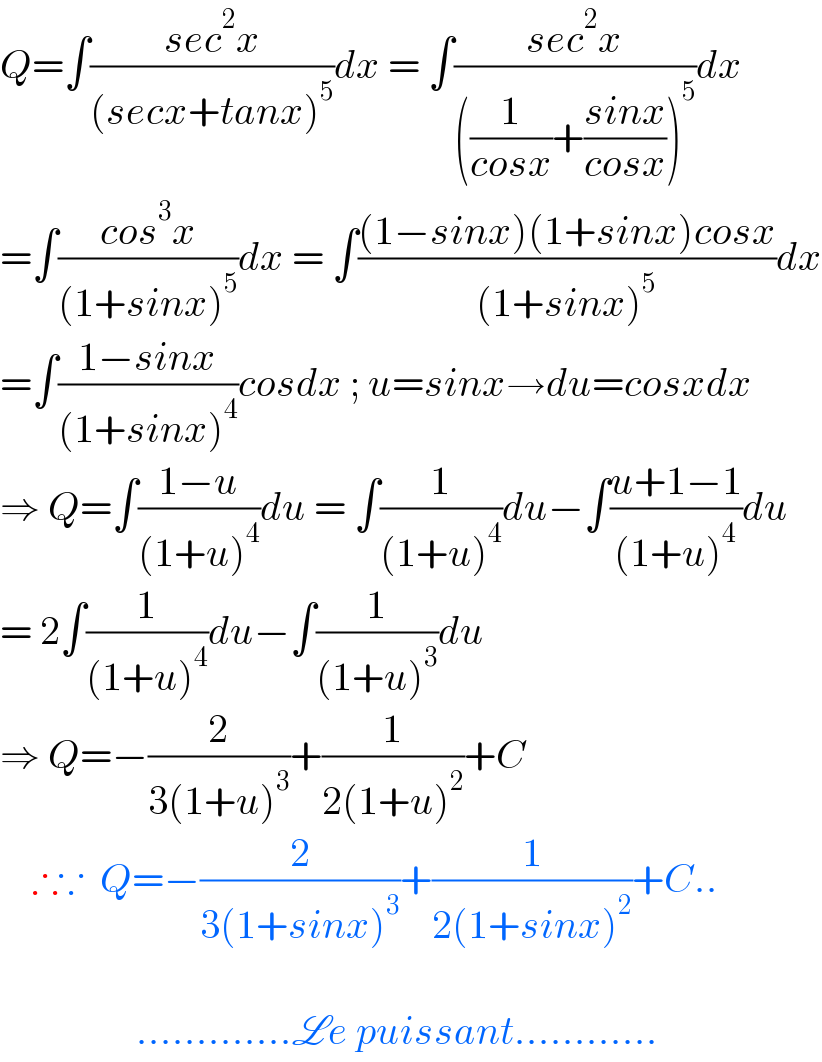Question Number 156869 by cortano last updated on 16/Oct/21

Answered by gsk2684 last updated on 16/Oct/21

$$\int\frac{\mathrm{sec}\:{x}\left(\mathrm{sec}\:{x}\left(\mathrm{sec}\:{x}+\mathrm{tan}\:{x}\right)\right)}{\left(\mathrm{sec}\:{x}+\mathrm{tan}\:{x}\right)^{\mathrm{6}} }{dx} \\ $$$${put}\:\mathrm{sec}\:{x}+\mathrm{tan}\:{x}={t},\mathrm{sec}\:{x}−\mathrm{tan}\:{x}=\frac{\mathrm{1}}{{t}}\Rightarrow \\ $$$$\mathrm{sec}\:{x}\mathrm{tan}\:{x}+\mathrm{sec}\:^{\mathrm{2}} {x}=\frac{{dt}}{{dx}},\:\mathrm{2sec}\:{x}={t}+\frac{\mathrm{1}}{{t}} \\ $$$$\int\frac{{t}+\frac{\mathrm{1}}{{t}}}{\mathrm{2}{t}^{\mathrm{6}} }{dt}=\frac{\mathrm{1}}{\mathrm{2}}\int\left({t}^{−\mathrm{5}} +{t}^{−\mathrm{7}} \right){dt} \\ $$$$=\frac{\mathrm{1}}{\mathrm{2}}\left(\frac{{t}^{−\mathrm{4}} }{−\mathrm{4}}+\frac{{t}^{−\mathrm{6}} }{−\mathrm{6}}\right)+{const} \\ $$$$=−\frac{\mathrm{1}}{\mathrm{8}\left(\mathrm{sec}\:{x}+\mathrm{tan}\:{x}\right)^{\mathrm{4}} }−\frac{\mathrm{1}}{\mathrm{12}\left(\mathrm{sec}\:{x}+\mathrm{tan}\:{x}\right)^{\mathrm{6}} }+{const} \\ $$
Commented by cortano last updated on 16/Oct/21

$${yes} \\ $$
Answered by puissant last updated on 16/Oct/21

$${Q}=\int\frac{{sec}^{\mathrm{2}} {x}}{\left({secx}+{tanx}\right)^{\mathrm{5}} }{dx}\:=\:\int\frac{{sec}^{\mathrm{2}} {x}}{\left(\frac{\mathrm{1}}{{cosx}}+\frac{{sinx}}{{cosx}}\right)^{\mathrm{5}} }{dx} \\ $$$$=\int\frac{{cos}^{\mathrm{3}} {x}}{\left(\mathrm{1}+{sinx}\right)^{\mathrm{5}} }{dx}\:=\:\int\frac{\left(\mathrm{1}−{sinx}\right)\left(\mathrm{1}+{sinx}\right){cosx}}{\left(\mathrm{1}+{sinx}\right)^{\mathrm{5}} }{dx} \\ $$$$=\int\frac{\mathrm{1}−{sinx}}{\left(\mathrm{1}+{sinx}\right)^{\mathrm{4}} }{cosdx}\:;\:{u}={sinx}\rightarrow{du}={cosxdx} \\ $$$$\Rightarrow\:{Q}=\int\frac{\mathrm{1}−{u}}{\left(\mathrm{1}+{u}\right)^{\mathrm{4}} }{du}\:=\:\int\frac{\mathrm{1}}{\left(\mathrm{1}+{u}\right)^{\mathrm{4}} }{du}−\int\frac{{u}+\mathrm{1}−\mathrm{1}}{\left(\mathrm{1}+{u}\right)^{\mathrm{4}} }{du} \\ $$$$=\:\mathrm{2}\int\frac{\mathrm{1}}{\left(\mathrm{1}+{u}\right)^{\mathrm{4}} }{du}−\int\frac{\mathrm{1}}{\left(\mathrm{1}+{u}\right)^{\mathrm{3}} }{du} \\ $$$$\Rightarrow\:{Q}=−\frac{\mathrm{2}}{\mathrm{3}\left(\mathrm{1}+{u}\right)^{\mathrm{3}} }+\frac{\mathrm{1}}{\mathrm{2}\left(\mathrm{1}+{u}\right)^{\mathrm{2}} }+{C} \\ $$$$\:\:\:\:\therefore\because\:\:{Q}=−\frac{\mathrm{2}}{\mathrm{3}\left(\mathrm{1}+{sinx}\right)^{\mathrm{3}} }+\frac{\mathrm{1}}{\mathrm{2}\left(\mathrm{1}+{sinx}\right)^{\mathrm{2}} }+{C}.. \\ $$$$ \\ $$$$\:\:\:\:\:\:\:\:\:\:\:\:\:\:\:\:\:………….\mathscr{L}{e}\:{puissant}………… \\ $$
Commented by cortano last updated on 16/Oct/21

$${yes} \\ $$
